How to spot fake emails like "Update Your Email Account" scam email
Phishing/ScamAlso Known As: Update Your Email Account phishing email
Get free scan and check if your device is infected.
Remove it nowTo use full-featured product, you have to purchase a license for Combo Cleaner. Seven days free trial available. Combo Cleaner is owned and operated by RCS LT, the parent company of PCRisk.com.
What kind of scam is "Update Your Email Account"?
After inspecting this letter, we concluded that it is a scam email written by scammers who aim to lure recipients into providing sensitive information. It is disguised as a letter from an email service provider and contains a link to a phishing website. This scam email should be ignored.
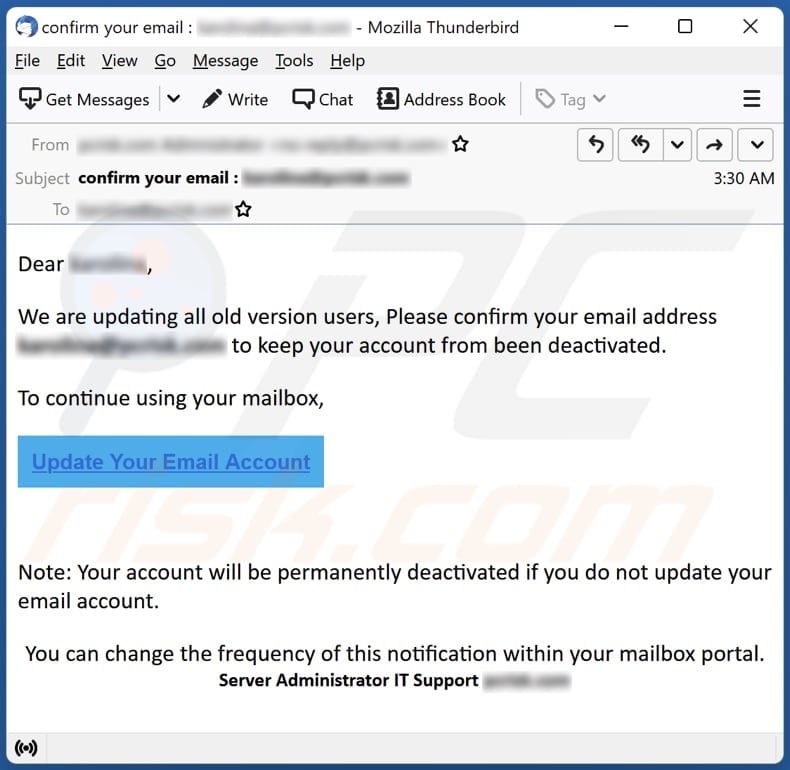
More about the "Update Your Email Account" scam email
This email urges recipients to confirm their email addresses. It claims that all old versions are being updated, and outdated accounts will be deactivated if not confirmed. This email contains the "Update Your Email Account" hyperlink that opens a fake login website.
Depending on the recipient's email service provider, the page opened via the provided hyperlink masquerades as Bing, Google, or another email account login page. It requests visitors to sign in using their email address and password. Entered login information is sent to scammers.
Scammers may use stolen email accounts to access personal emails, send spam, deliver malware, create accounts on various websites, and for other purposes. Stolen information (or accounts) may also be sold to third parties.
Moreover, scammers may try to access other accounts using obtained login information. Thus, victims who use the same email address and password for more than one account may lose those other accounts too.
| Name | Update Your Email Account Scam |
| Threat Type | Phishing, Scam, Social Engineering, Fraud |
| Fake Claim | Not confirmed email accounts will be deleted. |
| Related Domain | urban3d[.]co |
| Detection Names (urban3d[.]co) | Avira (Phishing), Combo Cleaner (Malware), ESET (Phishing), Kaspersky (Phishing), Sophos (Phishing), Full List Of Detections (VirusTotal) |
| Disguise | Letter from an email service provider |
| Symptoms | Unauthorized online purchases, changed online account passwords, identity theft, illegal access of the computer. |
| Distribution methods | Deceptive emails, rogue online pop-up ads, search engine poisoning techniques, misspelled domains. |
| Damage | Loss of sensitive private information, monetary loss, identity theft. |
| Malware Removal (Windows) |
To eliminate possible malware infections, scan your computer with legitimate antivirus software. Our security researchers recommend using Combo Cleaner. Download Combo CleanerTo use full-featured product, you have to purchase a license for Combo Cleaner. 7 days free trial available. Combo Cleaner is owned and operated by RCS LT, the parent company of PCRisk.com. |
Similar scam emails in general
Most phishing emails are disguised as letters from legitimate companies, organizations or other entities, or real people. Scammers use them to trick recipients into providing login information, credit card details, ID card information, or other personal info. They aim to obtain information via email or phishing websites (fake/deceptive pages).
Examples of phishing emails are "Your Account Is Set To Close Email Scam", "Data Backup Email Scam", and "USPS - Shipment Is Still Pending Email Scam". Threat actors also use emails to lure recipients into infecting their computers.
How do spam campaigns infect computers?
Emails used to deliver malware contain malicious website links or attachments. Recipients infect computers after downloading and executing malware (malicious files). Typically, threat actors use malicious MS Office, PDF documents, JavaScript files, executables, ISO files, archives containing malicious files, and other types of files to distribute malware.
How to avoid installation of malware?
Examine emails before opening links or attachments. Especially when emails are irrelevant and (or) sent from unknown addresses. Download software and files from official websites and stores only. Avoid downloads from P2P networks, free file hosting sites, shady websites, third-party downloaders, etc.
Do not trust advertisements and links on questionable web pages. Keep the operating system (and installed software) updated. Use reputed antivirus software for computer protection. Run system scans regularly. If you've already opened malicious attachments, we recommend running a scan with Combo Cleaner Antivirus for Windows to automatically eliminate infiltrated malware.
Text presented in the "Update Your Email Account scam" email letter:
Subject: confirm your email : ********
Dear ********,We are updating all old version users, Please confirm your email address ******** to keep your account from been deactivated.
To continue using your mailbox,
Update Your Email Account
Note: Your account will be permanently deactivated if you do not update your email account.
You can change the frequency of this notification within your mailbox portal.
Server Administrator IT Support ********
Screenshot of the phishing page imitating Bing login site:
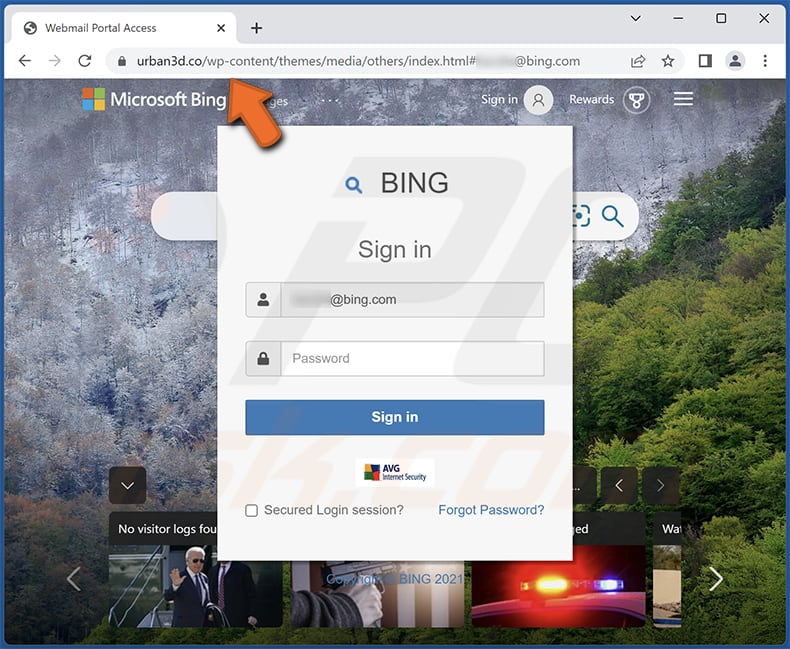
Yet another example of an account update-themed spam email promoting a phishing site:
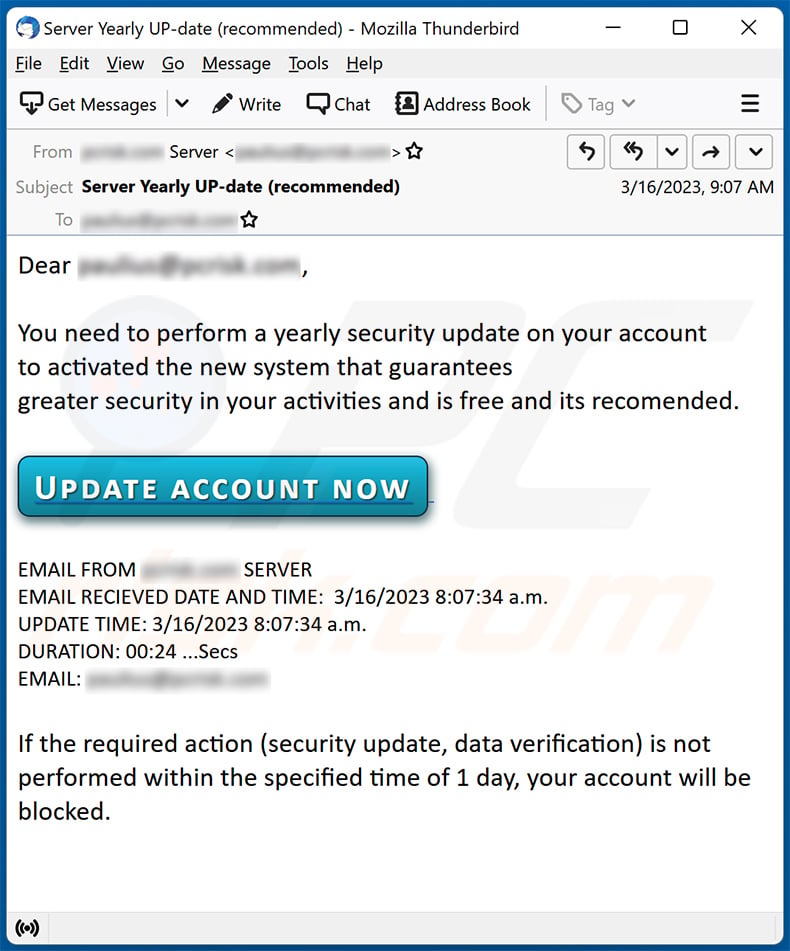
Text presented within:
Subject: Server Yearly UP-date (recommended)
Dear ********,You need to perform a yearly security update on your account
to activated the new system that guarantees
greater security in your activities and is free and its recomended.
Update account nowEMAIL FROM ******** SERVER
EMAIL RECIEVED DATE AND TIME: 3/16/2023 8:07:34 a.m.
UPDATE TIME: 3/16/2023 8:07:34 a.m.
DURATION: 00:24 ...Secs
EMAIL: ********If the required action (security update, data verification) is not performed within the specified time of 1 day, your account will be blocked.
Screenshot of the promoted phishing site:
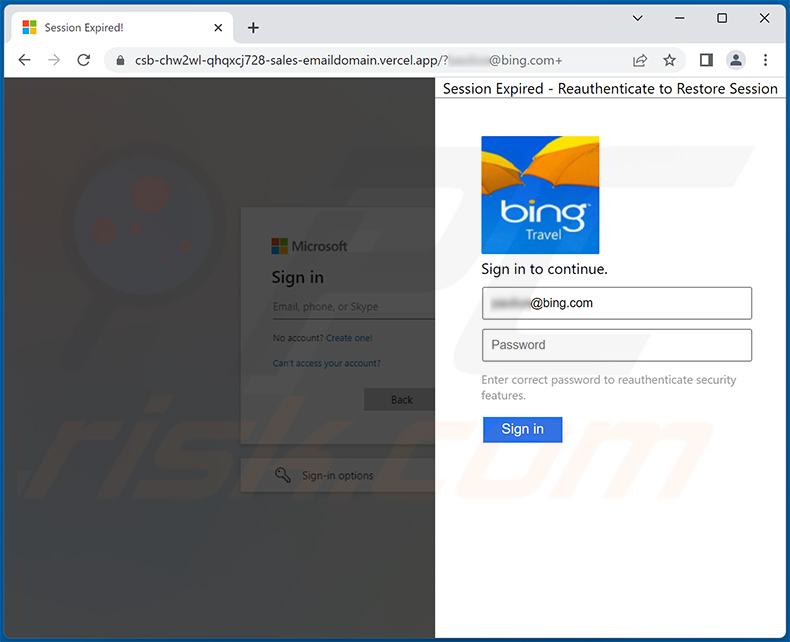
Another example of an email from "Update Your Email Account" spam campaign:
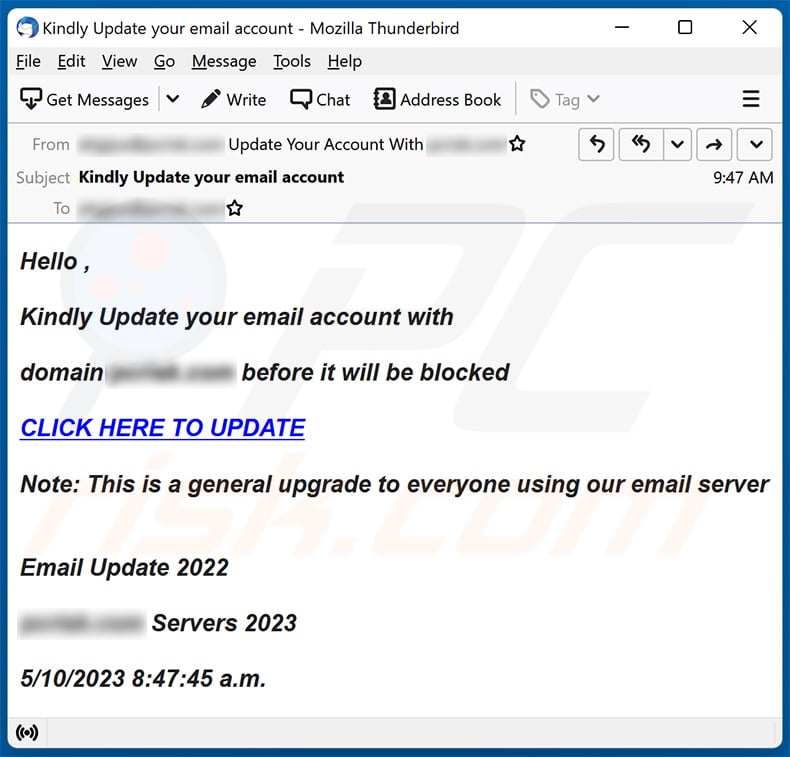
Text presented within:
Subject: Kindly Update your email account
Hello ,
Kindly Update your email account with
domain ******** before it will be blocked
CLICK HERE TO UPDATE
Note: This is a general upgrade to everyone using our email server
Email Update 2022
******** Servers 2023
5/10/2023 8:47:45 a.m.
Yet another example of an email from "Update Your Email Account" spam campaign:
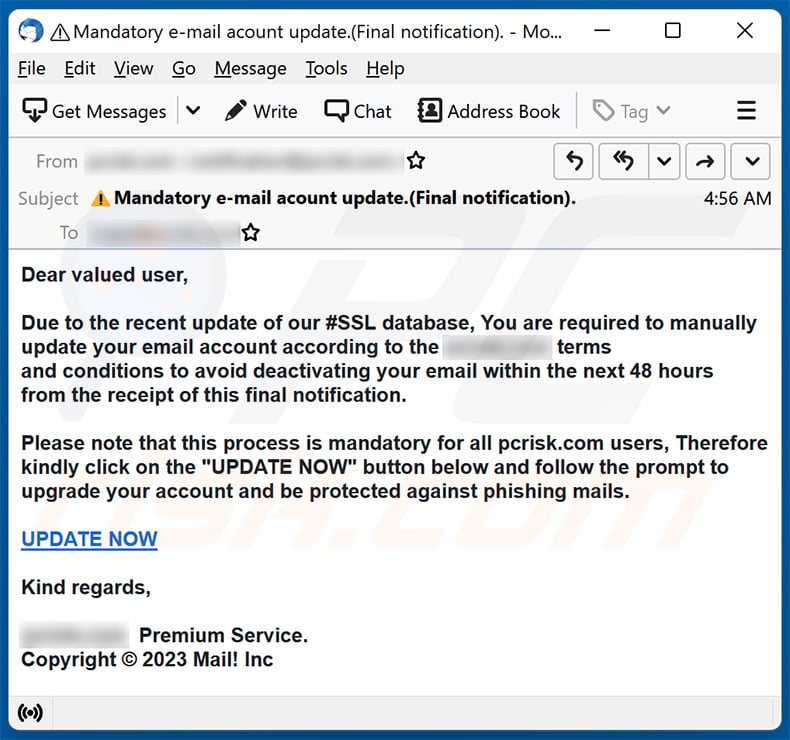
Text presented within:
Subject: Mandatory e-mail acount update.(Final notification).
Dear valued user,
Due to the recent update of our #SSL database, You are required to manually update your email account according to the ********** terms
and conditions to avoid deactivating your email within the next 48 hours from the receipt of this final notification.Please note that this process is mandatory for all ********** users, Therefore kindly click on the "UPDATE NOW" button below and follow the prompt to upgrade your account and be protected against phishing mails.
UPDATE NOW
Kind regards,
********** Premium Service.
Copyright © 2023 Mail! Inc
Screenshot of the promoted phishing site:
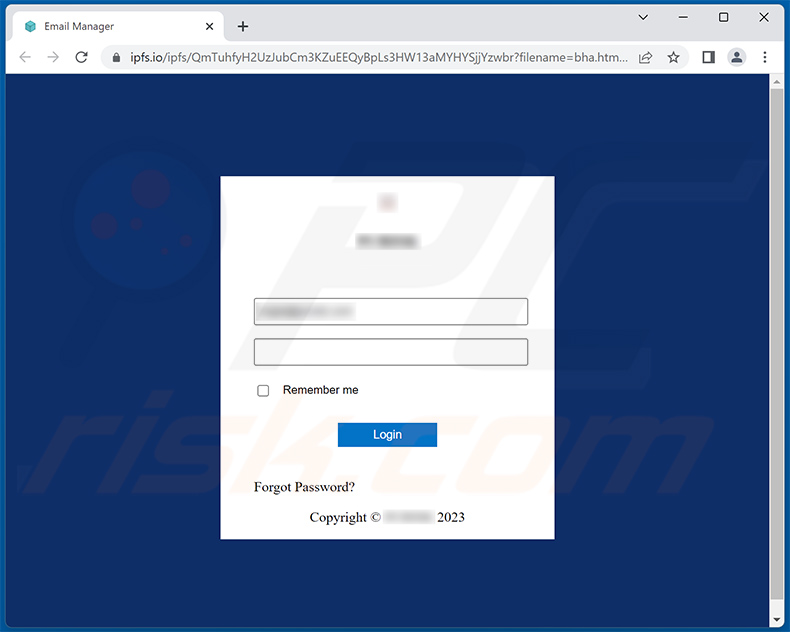
Another example of an email from "Update Your Email Account" spam campaign:
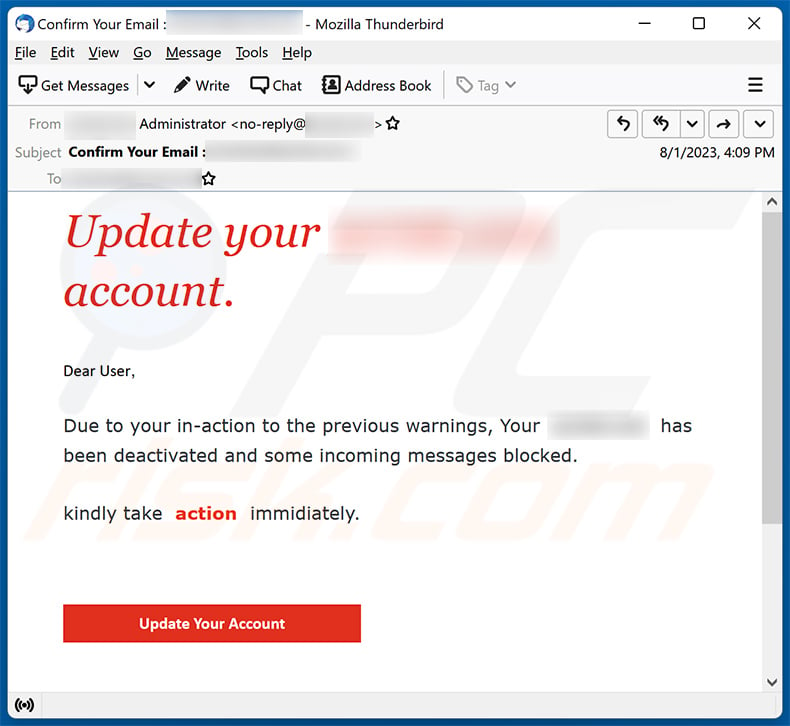
Text presented within:
Subject: Confirm Your Email : -
Update your - account.
Dear User,
Due to your in-action to the previous warnings, Your - has been deactivated and some incoming messages blocked.
kindly take action immidiately.
Update Your Account
This is an automated message, Please do not reply.
© 2017- 2022 Microsoft. All rights reserved Microsoft Corporation | One Microsoft Way Redmond, WA 98052-6399
Yet another example of an email from "Update Your Email Account" spam campaign:
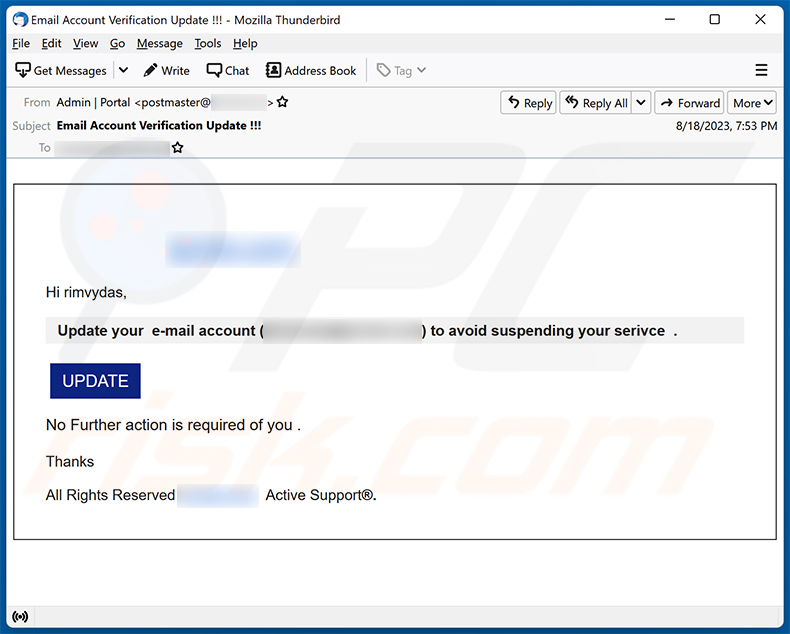
Text presented within:
Subject: Email Account Verification Update !!!
********Hi ********,
Update your e-mail account (********) to avoid suspending your serivce .
UPDATENo Further action is required of you .
Thanks
All Rights Reserved ******** Active Support®.
Yet another example of an email from "Update Your Email Account" spam campaign:
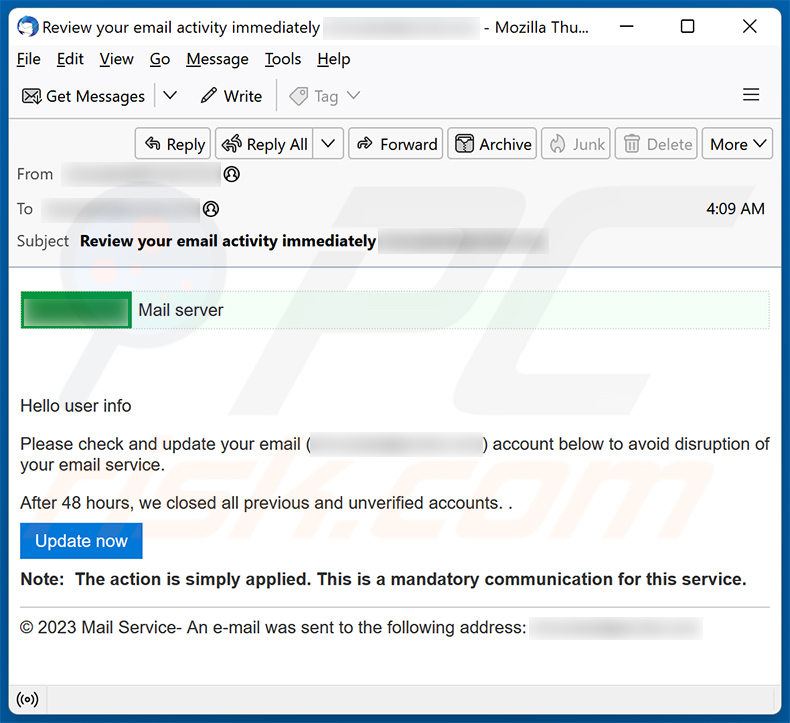
Text presented within:
Subject: Review your email activity immediately ********
******** Mail server
Hello user info
Please check and update your email (********) account below to avoid disruption of your email service.
After 48 hours, we closed all previous and unverified accounts. .
Update now
Note: The action is simply applied. This is a mandatory communication for this service.
© 2023 Mail Service- An e-mail was sent to the following address: ********
Yet another example of an email from "" spam campaign:
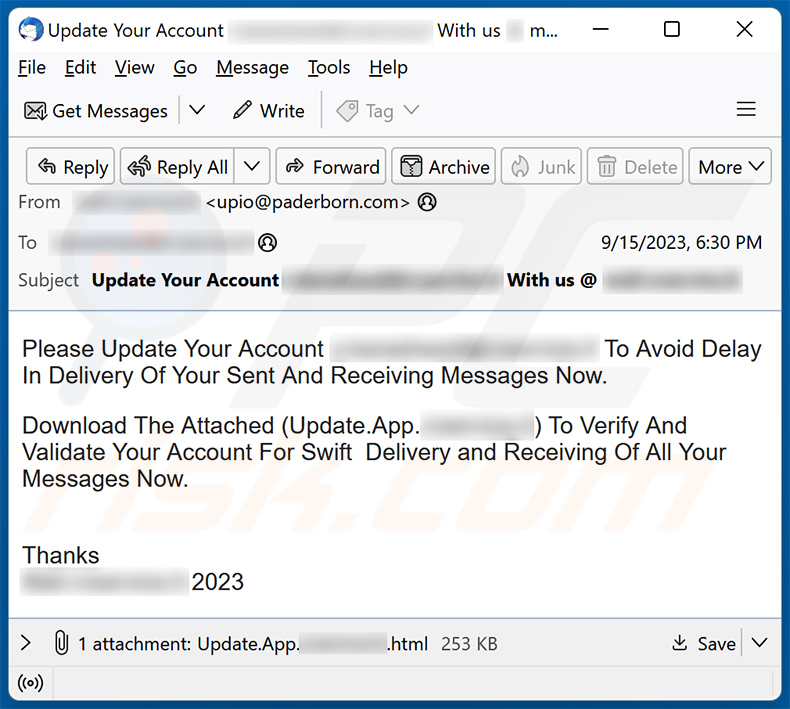
Text presented within:
Subject: Update Your Account ******** With us @ ********
Please Update Your Account ******** To Avoid Delay In Delivery Of Your Sent And Receiving Messages Now.
Download The Attached (Update.App.********) To Verify And Validate Your Account For Swift Delivery and Receiving Of All Your Messages Now.
Thanks
******** 2023
Screenshot of an HTML attachment designed for phishing purposes:
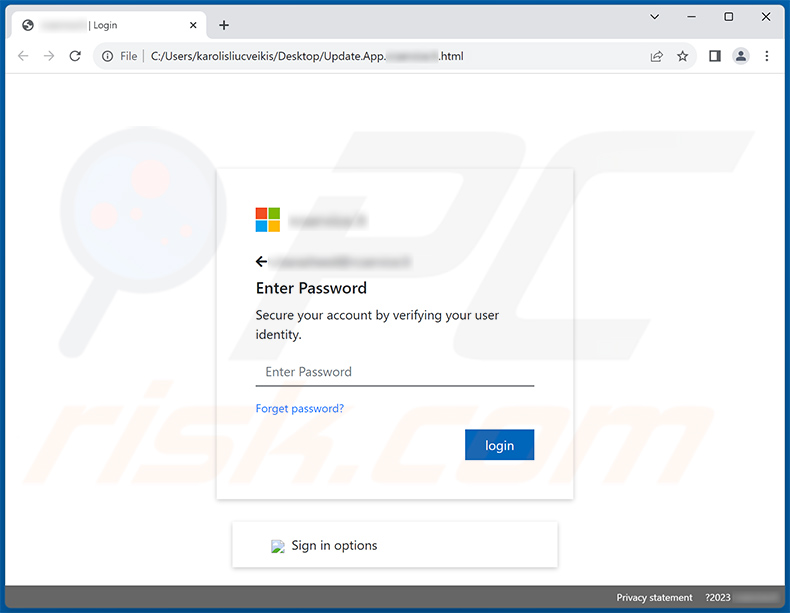
Instant automatic malware removal:
Manual threat removal might be a lengthy and complicated process that requires advanced IT skills. Combo Cleaner is a professional automatic malware removal tool that is recommended to get rid of malware. Download it by clicking the button below:
DOWNLOAD Combo CleanerBy downloading any software listed on this website you agree to our Privacy Policy and Terms of Use. To use full-featured product, you have to purchase a license for Combo Cleaner. 7 days free trial available. Combo Cleaner is owned and operated by RCS LT, the parent company of PCRisk.com.
Quick menu:
- What is Update Your Email Account phishing email?
- Types of malicious emails.
- How to spot a malicious email?
- What to do if you fell for an email scam?
Types of malicious emails:
![]() Phishing Emails
Phishing Emails
Most commonly, cybercriminals use deceptive emails to trick Internet users into giving away their sensitive private information, for example, login information for various online services, email accounts, or online banking information.
Such attacks are called phishing. In a phishing attack, cybercriminals usually send an email message with some popular service logo (for example, Microsoft, DHL, Amazon, Netflix), create urgency (wrong shipping address, expired password, etc.), and place a link which they hope their potential victims will click on.
After clicking the link presented in such email message, victims are redirected to a fake website that looks identical or extremely similar to the original one. Victims are then asked to enter their password, credit card details, or some other information that gets stolen by cybercriminals.
![]() Emails with Malicious Attachments
Emails with Malicious Attachments
Another popular attack vector is email spam with malicious attachments that infect users' computers with malware. Malicious attachments usually carry trojans that are capable of stealing passwords, banking information, and other sensitive information.
In such attacks, cybercriminals' main goal is to trick their potential victims into opening an infected email attachment. To achieve this goal, email messages usually talk about recently received invoices, faxes, or voice messages.
If a potential victim falls for the lure and opens the attachment, their computers get infected, and cybercriminals can collect a lot of sensitive information.
While it's a more complicated method to steal personal information (spam filters and antivirus programs usually detect such attempts), if successful, cybercriminals can get a much wider array of data and can collect information for a long period of time.
![]() Sextortion Emails
Sextortion Emails
This is a type of phishing. In this case, users receive an email claiming that a cybercriminal could access the webcam of the potential victim and has a video recording of one's masturbation.
To get rid of the video, victims are asked to pay a ransom (usually using Bitcoin or another cryptocurrency). Nevertheless, all of these claims are false - users who receive such emails should ignore and delete them.
How to spot a malicious email?
While cyber criminals try to make their lure emails look trustworthy, here are some things that you should look for when trying to spot a phishing email:
- Check the sender's ("from") email address: Hover your mouse over the "from" address and check if it's legitimate. For example, if you received an email from Microsoft, be sure to check if the email address is @microsoft.com and not something suspicious like @m1crosoft.com, @microsfot.com, @account-security-noreply.com, etc.
- Check for generic greetings: If the greeting in the email is "Dear user", "Dear @youremail.com", "Dear valued customer", this should raise suspiciousness. Most commonly, companies call you by your name. Lack of this information could signal a phishing attempt.
- Check the links in the email: Hover your mouse over the link presented in the email, if the link that appears seems suspicious, don't click it. For example, if you received an email from Microsoft and the link in the email shows that it will go to firebasestorage.googleapis.com/v0... you shouldn't trust it. It's best not to click any links in the emails but to visit the company website that sent you the email in the first place.
- Don't blindly trust email attachments: Most commonly, legitimate companies will ask you to log in to their website and to view any documents there; if you received an email with an attachment, it's a good idea to scan it with an antivirus application. Infected email attachments are a common attack vector used by cybercriminals.
To minimise the risk of opening phishing and malicious emails we recommend using Combo Cleaner Antivirus for Windows.
Example of a spam email:
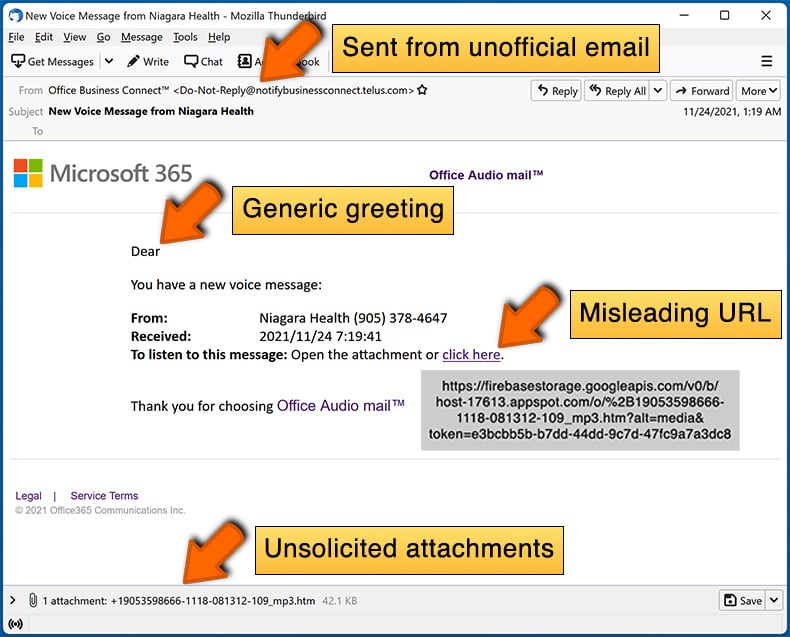
What to do if you fell for an email scam?
- If you clicked on a link in a phishing email and entered your password - be sure to change your password as soon as possible. Usually, cybercriminals collect stolen credentials and then sell them to other groups that use them for malicious purposes. If you change your password in a timely manner, there's a chance that criminals won't have enough time to do any damage.
- If you entered your credit card information - contact your bank as soon as possible and explain the situation. There's a good chance that you will need to cancel your compromised credit card and get a new one.
- If you see any signs of identity theft - you should immediately contact the Federal Trade Commission. This institution will collect information about your situation and create a personal recovery plan.
- If you opened a malicious attachment - your computer is probably infected, you should scan it with a reputable antivirus application. For this purpose, we recommend using Combo Cleaner Antivirus for Windows.
- Help other Internet users - report phishing emails to Anti-Phishing Working Group, FBI’s Internet Crime Complaint Center, National Fraud Information Center and U.S. Department of Justice.
Frequently Asked Questions (FAQ)
Why did I receive this email?
This scam email is not personal. As a rule, scammers behind phishing campaigns send the same letter to all recipients.
I have provided my personal information when tricked by this email, what should I do?
If you opened a phishing website (fake Bing, Google, or other email account login page) and provided your password, change all passwords as soon as possible.
I have downloaded and opened a malicious file attached to an email, is my computer infected?
It depends on the file type. For example, malicious Microsoft Office documents infect computers after opening them and enabling macros commands. Executables usually infect computers after their execution.
I have read the email but did not open the attachment, is my computer infected?
No, your computer is not infected if you did not open any links or attachments received from cybercriminals.
Will Combo Cleaner remove malware infections that were present in email attachment?
Yes, Combo Cleaner will eliminate malware from the operating system. This software can detect almost all known malware. It is recommended to run a full system scan because high-end malware usually hides deep in the system.
Share:

Tomas Meskauskas
Expert security researcher, professional malware analyst
I am passionate about computer security and technology. I have an experience of over 10 years working in various companies related to computer technical issue solving and Internet security. I have been working as an author and editor for pcrisk.com since 2010. Follow me on Twitter and LinkedIn to stay informed about the latest online security threats.
PCrisk security portal is brought by a company RCS LT.
Joined forces of security researchers help educate computer users about the latest online security threats. More information about the company RCS LT.
Our malware removal guides are free. However, if you want to support us you can send us a donation.
DonatePCrisk security portal is brought by a company RCS LT.
Joined forces of security researchers help educate computer users about the latest online security threats. More information about the company RCS LT.
Our malware removal guides are free. However, if you want to support us you can send us a donation.
Donate
▼ Show Discussion